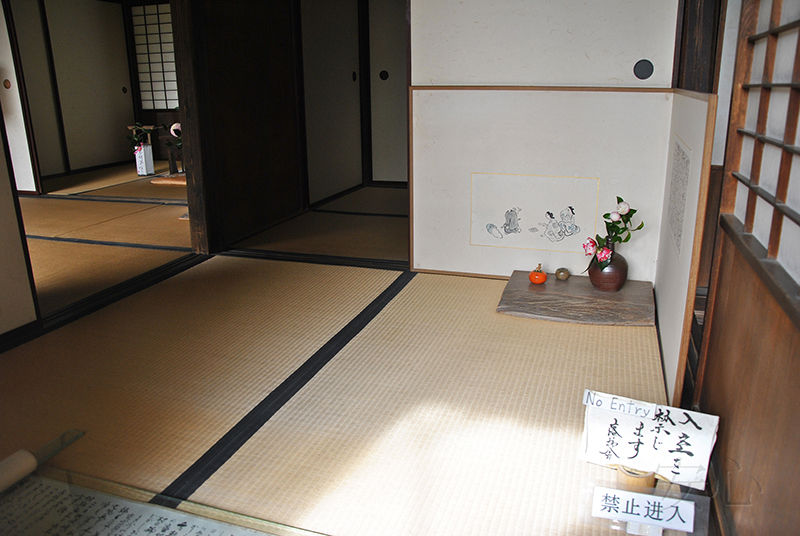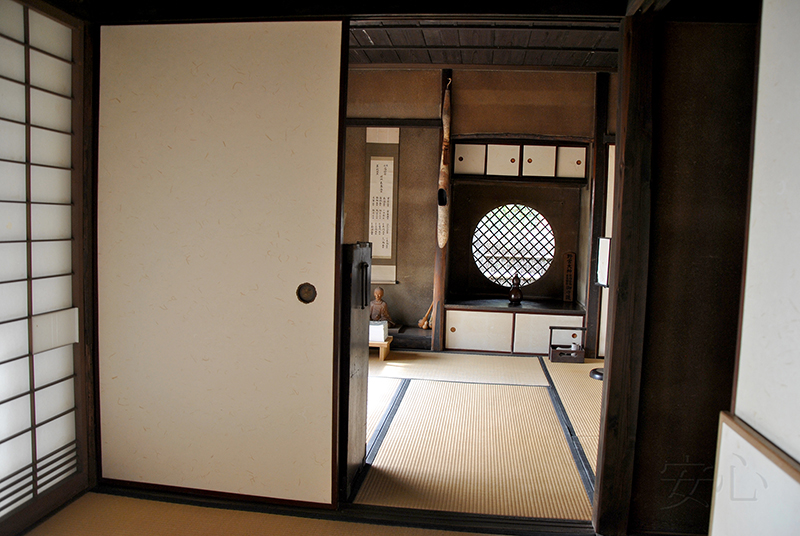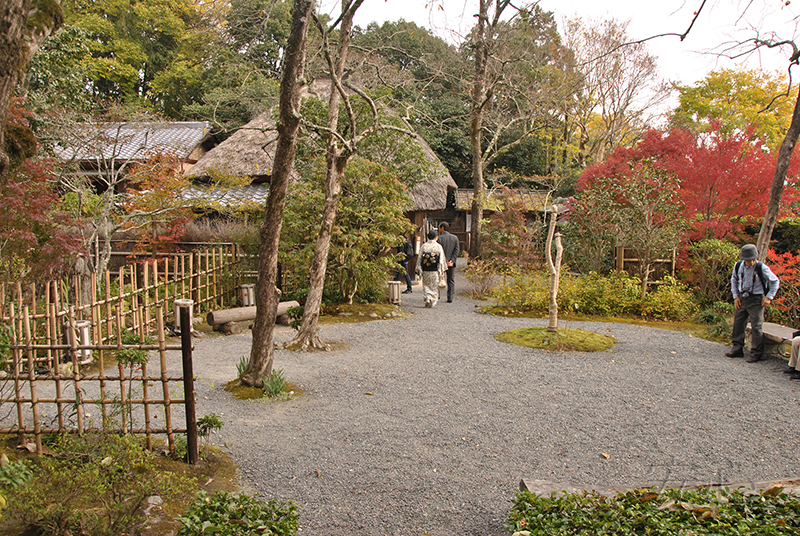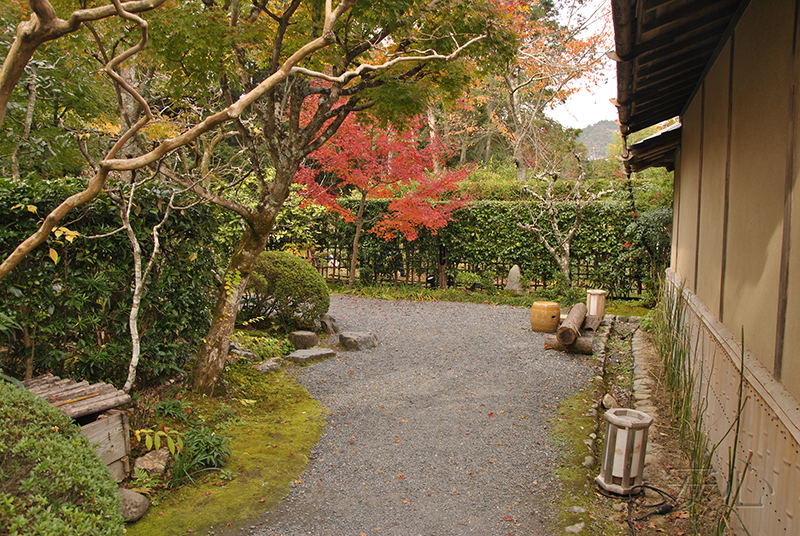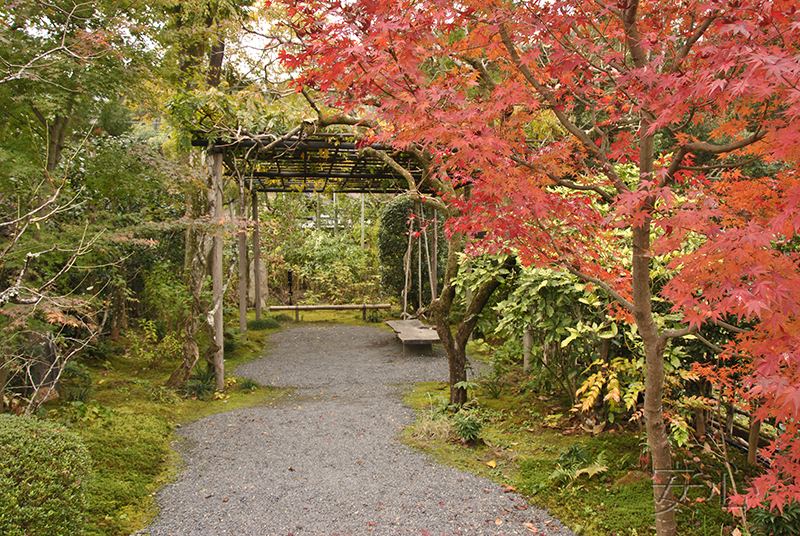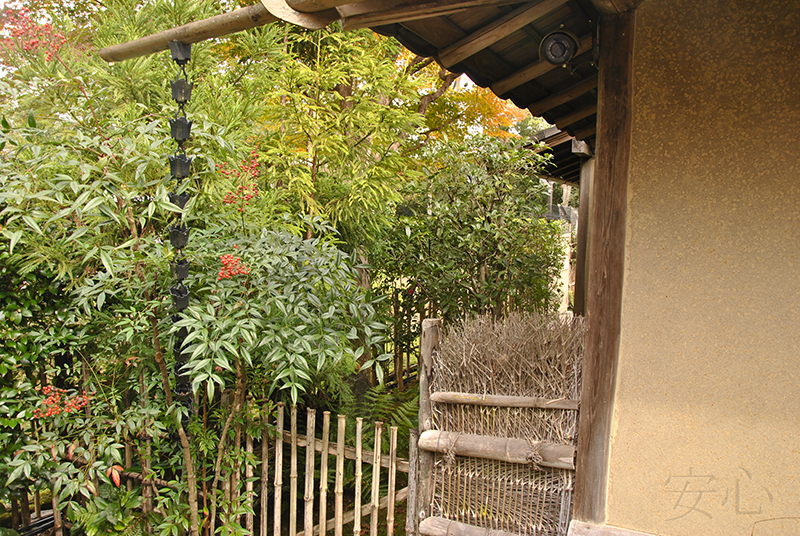
The hermitage Rakushisha
Rakushisha is the cottage of the Genroku poet Mukai Kyorai, one of the ten most prominent disciples of Matsuo Basho. The teacher once referred to Kyorai in this way: “In Kyoto there is Kyorai, who is in charge of haikai in Western Japan”.
Mukai Kyorai first trained as a samurai, but at age 23 he gave up martial service and turned to the writing of poetry. At first he was fond of classical poetry, but after meeting Basho, he joined his school and became a professional haiku poet.
For his work, Mukai Kyorai built a small cottage on the outskirts of Kyoto. As the story goes, Kyorai had about forty persimmon trees in his garden. One autumn when they were heavy with fruit, he had arranged to sell the persimmons. But the night before they were to be picked a great storm arose. The next morning not a single persimmon was left on the trees. Kyorai was enlightened by this experience, and from then on called the hut “Rakushisha” (the cottage of the fallen persimmons).
Of course, there are not so many persimmons in the garden now. But they grows, both in the garden itself and in front of the entrance, justifying the name of the house.
Already from the gate, you can see a hat and a straw raincoat hanging to the right of the entrance to the house. At that time, such a sign indicated that the owner was at home at the moment. And, although the poet has long been dead, the raincoat and hat now always hang in this place, as if making it clear that the poet is present in every corner, in every tree, in every stone.
Despite the fact that it is impossible to enter the house, the interior is perfectly visible. On the right is a room with a traditional Kamado cook stove.
On the left are two more rooms, separated by sliding doors (fusuma).
In the first one drawing caught my attention. Unfortunately, the story of the picture is not very clear. Perhaps the ladies say goodbye to a samurai who leaves, for example, for a war.
The second room is a study. All conditions for creativity have been made here: a large light space, decorative niches, paintings and, most importantly, a desk in front of a large window overlooking the garden.
There is a gravel path along the house.
At the end of the building is the entrance to the tea room, half covered by a reed screen. On the left is a tsukubai with a high chozubachi bowl. A stone tied with a black rope (sekimori-ishi) means that further passage is prohibited.
For those who have been inspired to write your own haiku after visiting this hut, there is a haiku box where you can post your original poetry (paper and pencils provided).
The poems posted in the box will be reviewed and those selected will be published in Rakushisha's seasonal magazines. Also you have to write your name, your age, your home address (in case someone actually liked it and were perhaps to send you a cheque for your effort).There is a small garden behind the house with a large number of flowers and trees, offering different views of the garden depending on which season you come to visit it in. We were there in the fall, and the main soloists of that time were, of course, maples and orange persimmons.
There is a tea house on the left.
Along the side wall is a well and water device shishi-odoshi. You can also see original lanterns and Chinese barrels-stools there.
And a little further there is a pergola, entwined with wisteria.
It is known that the master Basho visited Rakushisha three times: in 1689, 1691, and 1694. When he visited here the second time, he stayed from April 18 to May 5. At that time, the poet kept his diary called "Saga Nikki" and that visit is reflected there. So, walking in the bamboo grove next to the hut, Basho composed his famous poem:
The cuckoo –
Through the dense bamboo grove,
Moonlight seeping.
Noting in his diary that the sad desolation of the hut touches the soul much more than the past well-being:
Mandarin flowers.
Surely longs for the past
Dining room ...
At that time, it was raining continuously, and Basho, being in a stuffy room, accidentally found traces of a poetic postcard on the wall, which he had once pasted. The next day, the poet planned to leave Rakushisha, so in his next poem he expressed both sadness that he would have to leave this wonderful place and melancholy from prolonged rains:
Summer rains
Poem card peeled off
Leaving trace on the wall.
This last haiku is well known, widely taught in schools, and can be a topic of discussion among housewives. Probably, it was especially famous for the fact that this haiku was inscribed on a stone in the western corner of the Rakushisha garden.
Basho's last visit to Mukai Kyorai's hut was shortly before his death, in May 1694. The student outlived his teacher by 10 years.
There are other stones with inscribed poems in the garden. True, I could'nt find information about everyone, only about two pillars. The left one in the photo is a monument to Takahama Keshi, an outstanding poet of the haiku genre. It was built in the year of his death, in 1959. And on the right pillar is a haiku dedicated to Empress Akinori made in the Meiji era.
Rakushisha is one of the most important sites in Japanese literary history. In addition to Basho, many other famous haiku poets have been here. This hut has become a kind of haikai center which always welcomes haikai poets.
If you ever come to Arashiyama area, I highly advise you to take a retreat from the overcrowded tourist trails, and look into this wonderful quiet place. Who knows, maybe what you see will allow you to compose a beautiful haiku?
Garden Information:
Address: 20 Sagaogurayama Hinomyojincho, Ukyo Ward, Kyoto, 616-8391, Japan
Opening hours: from 9 a.m. to 5 p.m.
Closed: 31.12, 01.01
anshin©2011All rights reserved. When using the materials of the site, reference is obligatory.
Proposals for co-operation, as well as comments and suggestions on the site please send to the address: anshinsad@gmail.comtel: +7 (965) 121-80-60, 10am-20pm





